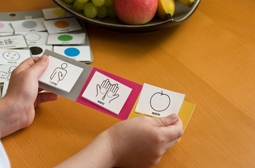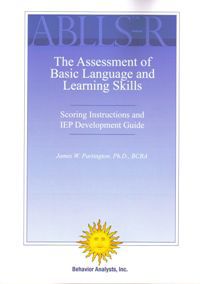Continuing our discussion on Applied Behavioral Analysis, we now focus on what exactly occurs during an ABA evaluation. Please send in any questions, comments or other topics you would like to see addressed.
 The ABA Evaluation
The ABA Evaluation
What should I expect when a BCBA walks through my front door?
Before I ever meet the child, I have an in-depth parent consultation and ask the parents to complete a brief behavioral and developmental skill inventory. When we talk, I ask parents about the situations in which the challenging behavior(s) occur the most, who do they occur the most with, what often “triggers” the behavior, and what the parents currently do after the behavior. I also ask parents what items and activities their child likes, so I have an idea what to use as reinforcers during my direct evaluation.
 When I conduct my evaluation, I use the Assessment of Basic Language and Learning Skills. The ABLLS is an assessment, curriculum guide, and skills tracking system. The ABLLS provides criterion-referenced information regarding a child’s current skills. It also provides a curriculum that can serve as a basis for the selection of educational objectives.
When I conduct my evaluation, I use the Assessment of Basic Language and Learning Skills. The ABLLS is an assessment, curriculum guide, and skills tracking system. The ABLLS provides criterion-referenced information regarding a child’s current skills. It also provides a curriculum that can serve as a basis for the selection of educational objectives.
I start the evaluation by just playing with the child to build rapport. Following my parent consultation, I bring toys and activities that are (hopefully) reinforcing to the child. I allow her to select any of my toys and play with it. I play interactively with the child to whatever extent is appropriate for his developmental level. After we have gotten to “know” each other and the child has found a toy she enjoys playing with, I show him the “first, then” visuals that I brought so he knows what to expect.
The “first” side has a “work” picture and the child selects a preferred item or activity and places it on the “then” side. I bring a choice board with many laminated and velcroed pictures. When evaluating an early learner that is not able to discriminate amongst the pictures and select one, I conduct a “preference assessment” by placing 2-3 items in front of the child and seeing what item he selects. I then put the actual item on the “then” side of the “first, then” chart. I then present one instruction, and immediately after the child responds (or allows me to prompt the response), I give her the toy. I set a visual timer and when the timer goes off, I conduct another preference assessment and do the process again. I bring multiple token economies to meet the needs of each individual child. A token economy is a board with a specified number of boxes. After each appropriate response, the child earns a “token.” I make a variety of tokens that the child may like, including pictures of Thomas the Train. After the board is filled and the child earned the specified number of tokens, he earns the reinforcer that he selected.
The ABLLS assessment is broken down into 25 domains. Within each domain, there are between 7-25 individual tasks that address the variety of individual developmental skills the child must demonstrate within that domain. Here are just a few of the domains and some examples of skills within each one.
- Visual Performance: Puzzles, form box, matching, block design imitation, patterning, seriation, picture sequences, mazes
- Receptive Language: Responds to own name, follows instructions in routine situations, selects common objects, touches body parts, selects adjectives, demonstrates a pretend action, selects pictures of actions, selects associated objects, selects by function, feature, class, receptive prepositions.
- Motor Imitation: Imitation of leg and foot movements, imitation of arm and hand movements, and imitation with objects.
- Requests: Requests help, requests missing items needed for a task, requests using sentences, requests with eye contact.
- Labeling (expressive language): Labels common objects, actions, emotions, body parts, adjectives, pronouns, prepositions, associated objects, and features, functions, and category of items.
- Intraverbals: This addresses more advanced conversation skills and abstract language such as filling in words from songs, answering WH questions, and describing items.
- Play and Leisure: Plays with toys as designed, multiple responses with a toy related to a theme, plays interactively with other students, sociodramatic play.
- Social Interactions: Shows interest in the behavior of others, looks at others to start a social interaction, imitates peer, returns greetings, and adjusts behavior based on changes in peer’s actions.
The ABLLS also has academic, motor, and functional self-care domains such as group instruction, follow classroom routines, generalized responding, reading skills, math skills, writing skills, spelling, dressing, eating, grooming, toileting, gross motor and fine motor skills.
 So at the end of the two hours, the child has played with many new and exciting toys, seen approximately 495 smilies and heard 501 specific verbal praises, I pack up my suitcase and he says (or waves), “Bye Sarah.” We are off to a great start.
So at the end of the two hours, the child has played with many new and exciting toys, seen approximately 495 smilies and heard 501 specific verbal praises, I pack up my suitcase and he says (or waves), “Bye Sarah.” We are off to a great start.
For more about Applied Behavior Analysis, ABA, check out these posts:
ABA Therapy- Who, What, Where, When, Why and How
Building Auditory Processing/Listening Comprehension Skills with ABA
